#microraptoria
Text
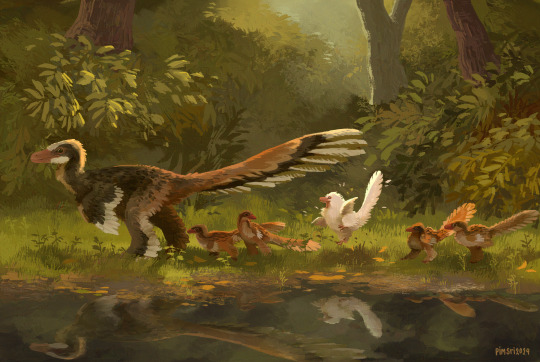
Baby albino changyuraptor spooked by her own reflection, realizing that she's not like her other siblings.
#changyuraptor#Microraptoria#microraptor#dromaeosaurid#theropod#dinosaur#animal#dinosaur art#paleoart#paleo art#animal art#pimsriart#pimsriart2024#forest#nature#scenery#water#reflection#baby#baby animal#baby dinosaur#chicks
10K notes
·
View notes
Text
I posted this on instagram but I feel it fits better on tumblr so here’s a little treat for you paleo guys :)
#Microraptor#microraptorinae#microraptoria#dromaeosaur#dromaeosaurid#raptor#feathered dinosaurs#theropod#theropoda#dinosaur#liaoning#liaoning fossil#paleontology#paleoart#paleoartist#art
95 notes
·
View notes
Photo
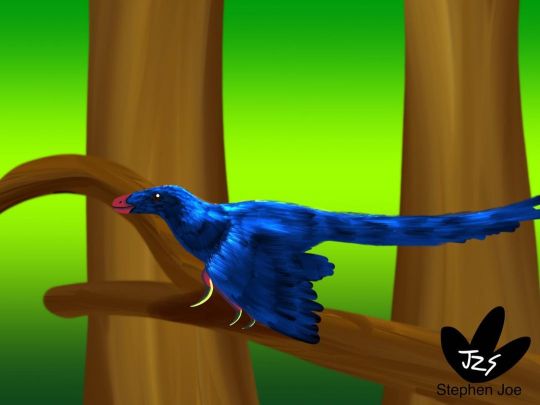
Day 18: Microraptor Microraptor gui is perched on a tree branch in closed forest environment. #Dinovember #Dinovember2022 #paleoart #sketchbookapp #artistsoninstagram #microraptor #microraptorgui #microraptoria #dromaeosauridae #pennaraptora #maniraptora #theropoda #dinosauria #dinosaur #feathereddinosaur #myart https://www.instagram.com/p/ClITz9lMUAe/?igshid=NGJjMDIxMWI=
#dinovember#dinovember2022#paleoart#sketchbookapp#artistsoninstagram#microraptor#microraptorgui#microraptoria#dromaeosauridae#pennaraptora#maniraptora#theropoda#dinosauria#dinosaur#feathereddinosaur#myart
57 notes
·
View notes
Text
Intro and Sophont List
This is a DnD rehaul inspired by @danbensen's Fellow Tetrapod story.
All races and classes available to DnD 5e will be reinterpreted as a sophont according to his guide for making FT sophonts. (Skill trees will be available for each sophont species).
Sophonts currently in FT will not be added until the current workload is complete. Sophont list below, although it's a heavy WIP.
Humans (Human, Hominid)
Noxissum (Aaracrocka, Pelagornis) -> thrill-seeking sophonts that live on cliffsides
Volutor (Aasimar, Polyneoptera)
Fixers [of Flesh] (Autognome, Canis) -> climbing oophagous sophonts with a focus on hunger
? (Bugbear, Barbourofelidae)
Harvau (Centaur, Mesohippus)
? (Changeling, Coleoidea)
Hemadele (Dhampir, Geospiza) -> blood-drinking sophonts that trade themselves for food
Deager (Dragonborn, Toxicofera) -> artistic sophonts with sprayed venom that dyes
Korrines (Dwarf, Herpestoidea) -> burrowing sophonts with deep familial bonds
Helbosi (Elf, Acariformes)
? (Fairy, Microraptoria)
? (Firbolg/Giant/Goliath, Pecora)
? (Genasi, Spiralia)
Breakers [They that Break the Waves] (Gnome, Otariidae)
? (Goblin, Holocephali)
? (Halfling, Callitrichidae)
? (Kenku, Corvides)
? (Kobold, Isoptera)
6 notes
·
View notes
Text

Wulong bohaiensis, a newly described microraptorine dinosaur whose name translates from Chinese into “dancing dragon,” referencing the pose of the exquisitely preserved holotype.
The Wulong specimen was determined to have been a juvenile, which implies drastically different growth and maturation rates for dinosaurs than for their avian descendants. The juvenile Wulong had more or less mature feathers rather than the down or not-quite-flight feathers characteristic of adolescent birds.
We do not know the coloration of Wulong, but I decided to model it off its close relative, the shiny, crow-sized Microraptor. This was my first time experimenting with iridescence and I’m not quite sure how I did.
#paleoblr#paleontology#paleoart#dinosaur art#dinosaur#dinosaurs#animals#birds#microraptor#microraptoria#dromaeosaur#dromaeosauridae#raptor#raptors#feathered dinosaurs#feathered raptor#feathered raptors#iridescence#feathered dinosaur#natural history#new discoveries#fossils#new dinosaur
403 notes
·
View notes
Text
Daily Dinosaur Facts: Day 4

Sinornithosaurus was originally thought to be venomous, but, what was first thought to be a venom sac, turned out to be a tooth ready to replace an old/worn one.
Image Source
#Daily#Dinosaur#Dinosaurs#Fact#Facts#DailyDinosaur#DailyDinosaurs#DailyDinosaurFact#DailyDinosaurFacts#Day4#Venom#Venomous#VenomSac#Tooth#Teeth#Sinorinithosaurus#Microraptorian#Microraptoria#Dromaeosaurid#Dromaeosauridae#Coelurosaur#Coelurosauria#Avetheropod#Avetheropoda#Orionide#Orionides#Tetanuran#Tetanurae#Averostran#Averostra
4 notes
·
View notes
Text
Changyuraptor yangi

By Scott Reid
Etymology: Long Feathered Robber
First Described By: Han et al., 2014
Classification: Dinosauromorpha, Dinosauriformes, Dracohors, Dinosauria, Saurischia, Eusaurischia, Theropoda, Neotheropoda, Averostra, Tetanurae, Orionides, Avetheropoda, Coelurosauria, Tyrannoraptora, Maniraptoromorpha, Maniraptoriformes, Maniraptora, Pennaraptora, Paraves, Eumaniraptora, Dromaeosauridae, Microraptoria
Status: Extinct
Time and Place: About 124.4 million years ago, in the Aptian of the Early Cretaceous


Changyuraptor is known from the Dawangzhangzi Bed of the Yixian Formation

Physical Description: Changyuraptor was a medium sized dinosaur, about 1.2 meters long - something like a modern turkey in terms of weight. It was covered from head to toe in feathers, including full wings on its arms, a large tail fan, and wings on its legs. It had a small, pointy head and long tail, while its body was fairly stocky. It also had sharp claws on its hands and sickle claws on its feet, like other raptor-dinosaurs. It’s tail was so long and feathered - with feathers reaching up to 30 centimeters in length and being the largest feathers known in a non-avian dinosaur - it would have allowed for softer landings for Changyuraptor. In short, it was probably the largest and fluffiest four-winged dinosaur known.
Diet: Changyuraptor would have primarily fed upon small animals like mammals, lizards, and amphibians.
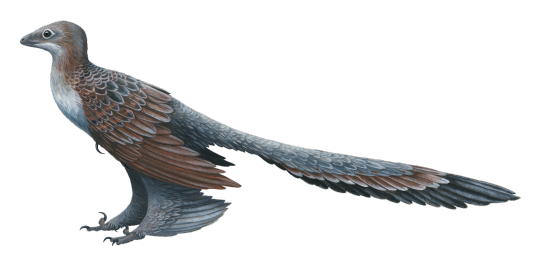
By Emily Willoughby, CC BY-SA 4.0
Behavior: Like Microraptor, Changyuraptor was probably capable of flight, making it one of the largest flying dinosaurs of the Mesozoic Era - with very few birds ever growing larger than it. It wouldn’t have been a particularly good flier though, only about as well as a chicken, taking off clumsily from the ground to go from area to area. It didn’t have enough strength in the chest and wing muscles to do much more than this, though it’s possible the hindlimb feathers would have allowed for some maneuvering in the air. It then could pounce on its prey, using its sickle claw to hold onto struggling animals before eating them.
More importantly; the wings, tail fan, and leg wings would have all been good display structures for Changyuraptor, which would have used them to communicate with other members of the species. These feathers would have signaled anger, a desire to mate, or danger, as feathers today are used by birds. It’s probable, then, that at least some fancy coloration may have been present on Changyuraptor to aid in the communication. Changyuraptor would have been a very active animal and most likely would have taken care of its young. In fact, it may have used its variety of wings and fans to help brood the nest.
Ecosystem: Changyuraptor lived in the Yixian Formation, a highly diverse ecosystem showcasing the evolution of birdie dinosaurs - like Changyuraptor - at the beginning of the Cretaceous period. A temperate, seasonal, and humid climate, it was much like the modern day northwestern Pacific Coast, though it would have seen snow on a regular basis, as well as notable dry seasons. It was a diverse coniferous forest, with a variety of flowering plants, ferns, horsetails, ginkgoes, cycads, seed ferns, and many others. Changyuraptor would have probably spent most of its time in the trees as well as on the ground, given its flight ability. There were a lot of freshwater lakes, and abundant volcanic eruptions.
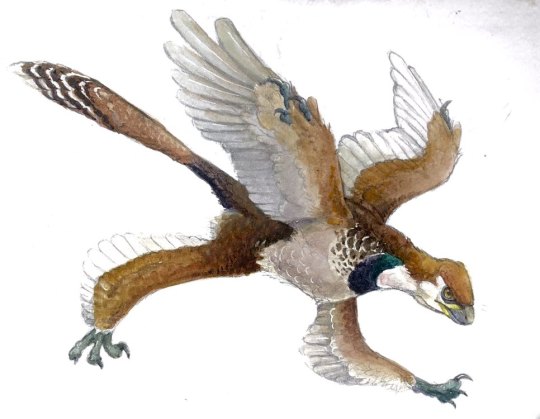
By Ripley Cook
Changyuraptor lived along so many other kinds of dinosaurs, it’s almost impossible to list them all. There were ankylosaurs like Liaoningosaurus and ornithopods like Bolong and Jinzhousaurus. There was the larger Compsognathid Sinosauropteryx, as well as many raptors in addition to Changyuraptor like the large Zhenyuanlong, Sinornithosaurus, and Tianyuraptor. There was also the Troodontid Jianianhualong, the seed eating protobird Jeholornis, smaller protobirds like Confuciusornis and Zhongornis, and the Anchiornithid Yixianosaurus. Opposite birds were there too like Dalingheornis and Shanweiniao, as well as near-birds like Archaeorhynchus, Eogranivora, Yanornis, Hongshanornis, and Longicrusavis. Non-dinosaurs like fish, amphibians, and lizards were also there; they along with mammals like Akidolestes, Sinobaatar, Sinodelphys, Chaoyangodens, and Eomaia would have been the primary prey of Changyuraptor. There were also Choristoderes like Hyphalosaurus and Monjurosuchus, as well as pterosaurs like Cathayopterus and Ningchengopterus. In short, a fascinating snapshot of Early Cretaceous life.
Other: Changyuraptor was closely related to - and preceded - Microraptor, one of the best known feathered dinosaurs; though we don’t know if it would have been colored like Microraptor, it’s possible it may have also had iridescent feathers like its later relative.
~ By Meig Dickson
Sources under the Cut
Amiot, R., X. Wang, Z. Zhou, X. X. Wang, E. Buffetaut, C. Lécuyer, Z. Ding, F. Fluteau, T. Hibino, N. Kusuhashi, J. Mo, V. Suteethorn, Y. Y. Wang, X. Xu, F. Zhang. 2011. Oxygen isotopes of East Asian dinosaurs reveal exceptionally cold Early Cretaceous climates. Proceedings of the National Academy of Sciences 108 (13): 5179 - 5183.
Benson, R.B.J. & Brussatte, S. (2012). Prehistoric Life. London: Dorling Kindersley. p. 332.
Choi, Charles (15 July 2014). "Bizarre Dinosaur Had 4 'Wings,' Long Tail Feathers". LiveScience.com. Retrieved 16 July 2014.
Gang Han; Luis M. Chiappe; Shu-An Ji; Michael Habib; Alan H. Turner; Anusuya Chinsamy; Xueling Liu & Lizhuo Han (15 July 2014). "A new raptorial dinosaur with exceptionally long feathering provides insights into dromaeosaurid flight performance". Nature Communications. 5: 4382.
Iacurci, Jenna (15 July 2014). "New Four-Winged Dinosaur Built for Flight". Nature World News. Retrieved 16 July 2014.
Larsson, Hans, Hone, David, Dececchi, T. Alexander, Sullivan, Corwin, Xu, Xing. "THE WINGED NON-AVIAN DINOSAUR MICRORAPTOR FED ON MAMMALS: IMPLICATIONS FOR THE JEHOL BIOTA ECOSYSTEM" "Program and Abstracts. 70th Anniversary Meeting Society of Vertebrate Paleontology October 2010" 114A.
Meng, F.X.; Gao, S.; Liu, X.M. (2008). “U-Pb zircon geochronology and geochemistry of volcanic rocks of the Yixian Formation in the Lingyuan area, western Liaoning, China”. Geological Bulletin of China. 27: 364–373.
Morgan, James (16 July 2014). "Four-winged dinosaur is 'biggest ever'". BBC News. Retrieved 16 July 2014.
Naish, Darren (2012). Planet Dinosaur: The Next Generation of Killer Dinosaurs. Firefly Books. p. 186.
Nicholas R. Longrich; David M. Martill; Brian Andres (2018). "Late Maastrichtian pterosaurs from North Africa and mass extinction of Pterosauria at the Cretaceous-Paleogene boundary". PLOS Biology. 16 (3): e2001663.
Pickrell, John (16 July 2014). "Four-winged dinosaur had record-breaking tail feathers". Australian Geographic Society. Retrieved 16 July 2014.
Wang, Y., S. Zheng, X. Yang, W. Zhang, Q. Ni. 2006. The biodiversity and palaeoclimate of confier floras from the Early Cretaceous deposits in western Liaoning, northeast China. International Symposium on Cretaceous Major Geological Events and Earth System: 56A.
Zhou, Z. 2006. Evolutionary radiation of the Jehol Biota: chronological and ecological perspectives. Geological Journal 41: 377-393.
#Changyuraptor#Changyuraptor yangi#Dromaeosaur#Raptor#Dinosaur#Bird#Birds#Dinosaurs#Feathered Dinosaurs#Paleontology#Prehistoric Life#Prehistory#Birblr#Palaeoblr#Factfile#Carnivore#Eurasia#Theropod Thursday#Cretaceous
263 notes
·
View notes
Photo

Microraptoria Color Changing Light
51 notes
·
View notes
Text
A World Without the K-PG Extinction: An Overview
In an alternate world where the K-PG Meteor, Chicxulub, ceased to hit Earth. Instead, it begins with it being caught in orbit of Earth with a slight trajectory modification early in its course towards the body. This would drastically impact the future of Earth and cause history to go according to plan (at least in this universe). The meteor would instead orbit for an extended period of time acting as a secondary natural moon. This is where this story begins.
Initially, things would continue as normal. The continental trajectory would be exactly the same into modern day, the orbital and rotational trajectory as well. What does change is what lives on Earth and some of the climate, although climate affected by orbital patterns remain the same, such as the Pleistocene-Holocene Ice Age in the LGM (last glacial maximum).
Multiple lineages were present towards the late Cretaceous that would be seen to persist past the original boundary. Some of these lineages would come and give rise to entirely unique anatomical structures and diversify across continents, and some would go extinct for a variety of reasons.
This project is an ongoing W.I.P project, stay tuned for updates.
Lineages that were present 66 MYA:
Variety of Birds, Mammals, Squamates, Amphibians, Fish, Turtles, etc.
Tyrannosauroids
Ceratosauria (Noasaurs, Abelisaurs)
Troodontids
Dromaeosauridae (Velociraptorines, Dromaeosaurinae, Microraptoria)
Halszkaraptoria
Alvarezsauridae
Therizinosaurs
Unenlagiinae
Orninthomimosaurs
Oviraptorosaurs (Caenagnathines, Oviraptorids)
Megaraptora
Titanosauria
Pachycephalosauria
Orninthopods (Rhabdodontids, Saurolophines, Lambeosaurinae, Parkosaurs, Elasmaria)
Ceratopsia (Centrosauria, Chasmosaurine, Leptoceratopsids, Protoceratopsids, Bagaceratopsids)
Ankylosauria (Nodosauria, Ankylosauria)
Pterosauria (Nyctosaurids, azhdarchids, thalassodromaeids, pteranodontid)
Mosasaurs
Pleisiosaurs
0 notes
Photo
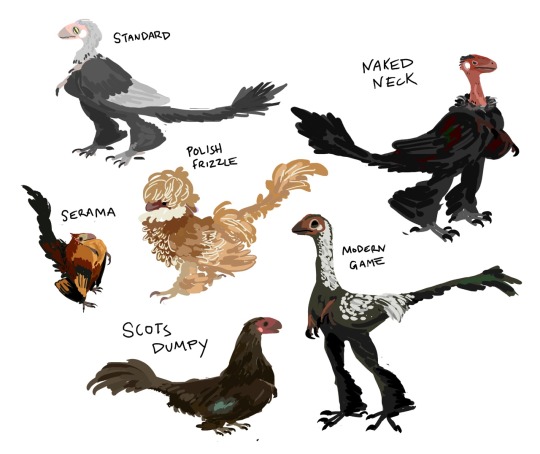
MICRORAPTORS AS FANCY ROOSTERS... scots dumpy is my fav. he has but the teensiest of legwings but he is noble and kind and a friend
#dumb draws#microraptoria#microraptors#scots dumpy#serama#naked neck#modern game fowl#polish frizzle#fancy chickens
210 notes
·
View notes
Text
microraptoria replied to your post:Had a major panic attack when Veronica drove me to...
Oh honey. *curls around protectively*
*cling*
0 notes
Text
microraptoria said: You can do it. All the luck!
ahskjdhksjhd thanks!
1 note
·
View note
Text
and now im imaging bevel taking the star saber and being all
"you must be this tall to wield Father's sword-"
"OMG BEVEL SHUT UP!"
"i'm sorry but its a regulation i just made up. it's law now."
"WHY?"
7 notes
·
View notes
Text
microraptoria replied to your post:raiyena answered your question:i want my second...
Skydancer.
which flavor?
1 note
·
View note
Note
NICE THOUGHTS CHALLENGE. Once you get this you have to say 5 nice things about yourself publicly and then send this to 10 of your favorite followers. But not back to me, of course. :)
I have been thinking better things lately.
I can keep a straight face.
95% of the time I’ll get up and take my dog out within a minute of her bothering me.
I have not yelled at my least favorite coworker yet.
I’ve been rping again.
2 notes
·
View notes
Photo
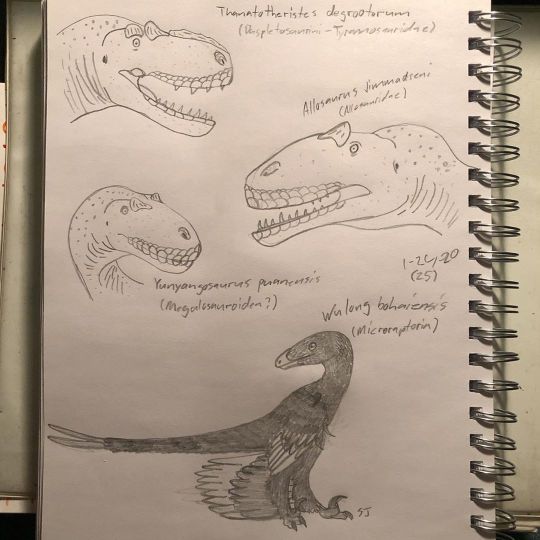
The non-avian theropods of January 2020. #paleoart #sketchbook #myart #theropoda #tyrannosauridae #allosauridae #megalosauroidea #carnosauria #coelurosauria #microraptoria #dromaeosauridae #avetheropoda https://www.instagram.com/p/B7xJDZtlwf1/?igshid=r3effaotoufv
#paleoart#sketchbook#myart#theropoda#tyrannosauridae#allosauridae#megalosauroidea#carnosauria#coelurosauria#microraptoria#dromaeosauridae#avetheropoda
1 note
·
View note